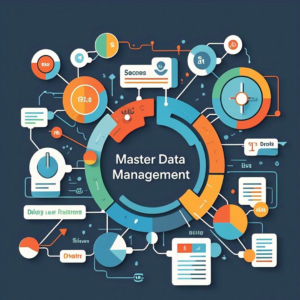1. Master Data Management in Cloud Computing
Master Data Management (MDM) plays a crucial role in cloud computing. It ensures foundational data entities across organizations are consistent, accurate, and reliable. As organizations transition to decentralized data architectures, MDM’s importance grows, especially regarding cloud computing security. This blog explores MDM within a data mesh, covering its significance, challenges, design patterns, architecture, and the decision-making process of building or buying MDM solutions.
2. Understanding Master Data in Hybrid Cloud Environments
Master data refers to critical non-transactional entities shared across various departments and systems. This includes customers, products, suppliers, and locations. Master data serves as the backbone of transactional data, providing essential context to business operations. For instance, a sales report’s figures represent transactional data, while customer details signify master data.
In a hybrid cloud environment, decentralized data ownership means multiple teams may manage their versions of master data. This can lead to discrepancies and inaccuracies, impacting analytics and decision-making processes. Therefore, establishing a robust MDM strategy is essential to maintain a single source of truth across the organization.
3. The Importance of Data Security and a Single Source of Truth
A single source of truth (SSOT) is vital for ensuring all stakeholders work with consistent data. In a data mesh, where data is distributed across various domains, achieving SSOT can be challenging. Without effective MDM, different teams might create their versions of master data, leading to confusion and mistrust.
For example, if one team refers to a customer by one name, while another uses a different identifier, it can lead to duplicates and erroneous reporting. This inconsistency can erode trust in data-driven insights and hinder collaboration. MDM helps mitigate these issues by providing a framework for managing master data consistently, particularly in hybrid cloud solutions.
4. Causes of Discrepancies in Master Data
Several factors contribute to discrepancies in master data:
4.1 Inconsistent Naming Conventions
Different teams may adopt varying naming conventions, leading to duplicates and confusion, such as “John Doe” versus “Doe, John.”
4.2 Data Migration and Duplication
As organizations scale, data often migrates across departments, resulting in multiple copies. Each copy may be modified independently, exacerbating inconsistencies.
4.3 Lack of Governance
Without a centralized governance framework, teams may neglect standardized processes for managing master data, leading to variations in quality.
4.4 Integration Challenges
Integrating data from disparate systems can introduce errors, especially if systems have different models or formats.
4.5 Human Error
Manual data entry and updates can lead to mistakes, complicating the accuracy of master data.
5. MDM Design Patterns in Managed Services
To manage master data effectively in a hybrid cloud environment, organizations can adopt several design patterns:
5.1 Registry-Based System
In this approach, master data is maintained within individual systems while a central registry tracks records. This helps identify duplicates and ensures all systems reference the same unique identifiers.
5.2 Consolidation-Based System
This pattern consolidates master data from multiple systems into a central hub that all surrounding systems reference, ensuring changes are reflected organization-wide.
5.3 Repository-Based System
In this model, master data is created and maintained in a central repository, serving as the record for all other systems accessing their needs.
Each pattern has advantages and challenges. The choice of which to implement depends on the organization’s specific requirements and data architecture.
6. MDM Architecture for Cloud Computing Solutions
The architecture of MDM in a hybrid cloud environment must accommodate decentralized data ownership while ensuring consistency and accuracy. Two primary strategies can be employed:
6.1 Domain-Oriented MDM
This approach references a single MDM domain by all data products across the organization. It is effective when significant overlap exists in master data across domains.
6.2 Domain-Level MDM
If overlap between master data is minimal, each domain may maintain its master data. Each domain manages its master data while data products refer to relevant domain-specific .
A hybrid approach can also be adopted, where certain master data entities are managed centrally while others are maintained locally. This flexibility allows organizations to tailor their MDM strategy effectively.
7. Build vs. Buy: MDM Solutions and Security Considerations
When implementing MDM, organizations face a crucial decision: build a custom solution or purchase a third-party tool. This decision hinges on several factors:
7.1 Cost
Building a custom MDM solution can be expensive, requiring considerable resources. Conversely, purchasing a pre-built solution may be more cost-effective but could limit customization.
7.2 Customization
A custom-built MDM solution can be tailored to fit the organization’s specific needs. However, achieving such customization requires in-depth knowledge of MDM principles.
7.3 Time to Implement
Developing a custom solution can be time-consuming, delaying MDM benefits. Purchasing a solution can facilitate quicker implementation and faster realization of benefits.
7.4 Scalability
Organizations must weigh whether the chosen solution can scale with their growth. A custom solution may require ongoing development, while a third-party solution may come with built-in scalability.
7.5 Integration
The ability of the MDM solution to integrate with existing systems is crucial. Evaluating how easily a solution can connect with current data architecture is essential for maintaining data security.
8. Conclusion
Master Data Management is pivotal for successful cloud computing solutions. By establishing a robust MDM strategy, particularly in hybrid cloud contexts, organizations ensure their master data remains consistent, accurate, and reliable. Incorporating Hybrid cloud best practices further enhances data governance, security, and scalability, enabling seamless integration across diverse environments. Ultimately, this leads to better decision-making and fosters collaboration across departments. As organizations navigate the complexities of MDM, they must consider their design patterns, architecture, and build vs. buy decision to create a solution that meets their unique needs. Doing so positions them to leverage the full potential of cloud computing while ensuring data security and compliance.
Do you like to read more educational content? Read our blogs at Cloudastra Technologies or contact us for business enquiry at Cloudastra Contact Us.
